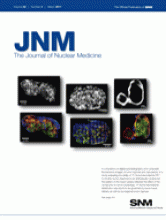TO THE EDITOR: In a recent study comparing 3′-deoxy-3′-18F-fluorothymidine (18F-FLT) and 18F-FDG for therapy monitoring in 11 nonseminomatous germ cell tumor (NSGCT) patients, Pfannenberg et al. (1) reported 2 patients in whom resected residual masses contained mature teratoma and harbored a low 18F-FLT uptake (mean standardized uptake value [SUVmean], 1.4 and 0.8) similar to that observed in 2 patients with necrosis (SUVmean, 1.3 and 1.3).
Cisplatin-based chemotherapy has dramatically improved the survival of patients with metastatic testicular cancer, with a cure rate of 80%–90%. However, detection of mature teratoma within residual masses remains a clinical problem in NSGCT patients. Mature teratoma, which is present in 30%–70% of cases (2), requires surgical removal because of the risk of late malignant transformation (3) and because it can enlarge after the course of chemotherapy (the so-called growing teratoma syndrome (4)). 18F-FDG imaging cannot differentiate necrotic or fibrotic tissues from mature teratoma in NSGCT residual masses, because all are 18F-FDG–negative. Hence, the identification of a new tracer capable of detecting mature teratoma within residual NSGCT masses would be of great clinical value.
Because 18F-FLT is well correlated with Ki67 immunohistochemistry studies (5), a faint or negative staining for this biomarker in a given histologic type makes it highly likely that 18F-FLT would not be a useful tracer. Hence, both patients in the study from Pfannenberg had a Ki67 visual score of 20% or less. Therefore, we aimed at testing Ki67 staining in a larger series of resected mature teratoma lesions. We identified 7 consecutive patients in whom 21 residual masses had been resected at the François Baclesse Cancer Center. All patients had mixed NSGCT and had received cisplatin-based chemotherapy for metastatic NSGCT tumors. Visual scoring of Ki67 immunohistochemistry studies revealed a low proliferation index (mean, 8% ± 9%). These results indicate that significant 18F-FLT uptake by mature teratoma lesions in NSGCT patients is unlikely.
Researchers from our group have developed a model of cisplatin plus retinoic acid–induced mature teratoma in nude rats bearing NTERA-2 tumors, a human NSGCT (6). The decrease in 18F-FDG uptake induced by cisplatin-based treatment in our model was indicated by the 63% reduction in SUVmean. This value is comparable to those reported by Pfannenberg et al. in the 2 patients with mature teratoma lesions after treatment: one patient showed an 82% reduction in SUVmean, and a second patient showed 58%. Also, the histopathologic patterns (i.e., glandular differentiation) observed in our model matched the pattern observed in the series of patients in whom we studied Ki67 staining. We showed, in our preclinical model, that imaging of integrin expression by means of 99mTc-labeled RGD accurately distinguishes between mature teratoma and necrosis, the latter having been obtained by high-dose chemotherapy in rats bearing NCCIT tumor, another human NSGCT highly responsive to cisplatin (7).
Mature teratoma formation is also an issue after the therapeutic transplantation of human embryonic stem cells. In that setting, our immunohistochemistry and preclinical results are in accordance with findings from Cao et al. (8), who showed in a preclinical model that mature teratoma lesions did not take up 18F-FLT but had a high avidity for a 64Cu-labeled RGD tetramer.
In conclusion, we believe that testing whether 18F-FLT PET could identify mature teratoma in residual masses after chemotherapy for metastatic NSGCT tumors in a large series of patients is unlikely to be productive. Rather, findings reported here warrant future clinical trials with radiolabeled RGD probes. We propose that PET or SPECT of integrin expression could form part of a multimodality analysis paradigm, together with other parameters, such as histology of the primary (presence of teratocarcinoma), degree of tumor shrinkage assessed by CT (9), and 18F-FDG PET kinetic analysis (10).
Acknowledgments
This work was supported by the French Ligue contre le cancer, Comité du Calvados.
- © 2011 by Society of Nuclear Medicine







